小学英语教师全英教案课程
- 格式:docx
- 大小:15.11 KB
- 文档页数:4

小学英语教育教学教案设计(精选9篇)(经典版)编制人:__________________审核人:__________________审批人:__________________编制单位:__________________编制时间:____年____月____日序言下载提示:该文档是本店铺精心编制而成的,希望大家下载后,能够帮助大家解决实际问题。
文档下载后可定制修改,请根据实际需要进行调整和使用,谢谢!并且,本店铺为大家提供各种类型的经典范文,如总结报告、心得体会、应急预案、会议记录、条据书信、合同协议、规章制度、教学资料、作文大全、其他范文等等,想了解不同范文格式和写法,敬请关注!Download tips: This document is carefully compiled by this editor. I hope that after you download it, it can help you solve practical problems. The document can be customized and modified after downloading, please adjust and use it according to actual needs, thank you!Moreover, our store provides various types of classic sample essays, such as summary reports, insights, emergency plans, meeting minutes, evidence letters, contract agreements, rules and regulations, teaching materials, essay summaries, and other sample essays. If you would like to learn about different sample formats and writing methods, please pay attention!小学英语教育教学教案设计(精选9篇)小学英语教育教学教案设计(精选9篇)2024-04-14 12:07:23小学英语教学设计(精选6篇)推荐度:小学英语教学设计范文最新6篇推荐度:热点范文英语(英文:English)是一种西日耳曼语支,最早被中世纪的英国使用,并因其广阔的殖民地而成为世界使用面积最广的语言。
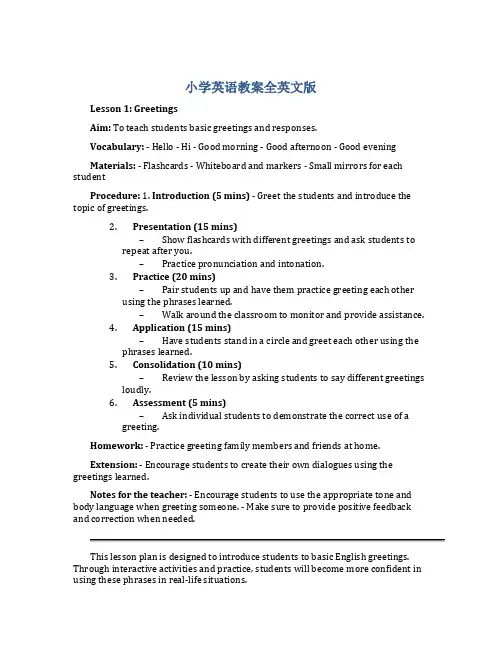
小学英语教案全英文版Lesson 1: GreetingsAim: To teach students basic greetings and responses.Vocabulary: - Hello - Hi - Good morning - Good afternoon - Good eveningMaterials: - Flashcards - Whiteboard and markers - Small mirrors for each studentProcedure: 1. Introduction (5 mins) - Greet the students and introduce the topic of greetings.2.Presentation (15 mins)–Show flashcards with different greetings and ask students to repeat after you.–Practice pronunciation and intonation.3.Practice (20 mins)–Pair students up and have them practice greeting each other using the phrases learned.–Walk around the classroom to monitor and provide assistance.4.Application (15 mins)–Have students stand in a circle and greet each other using the phrases learned.5.Consolidation (10 mins)–Review the lesson by asking students to say different greetings loudly.6.Assessment (5 mins)–Ask individual students to demonstrate the correct use of a greeting.Homework: - Practice greeting family members and friends at home.Extension: - Encourage students to create their own dialogues using the greetings learned.Notes for the teacher: - Encourage students to use the appropriate tone and body language when greeting someone. - Make sure to provide positive feedback and correction when needed.This lesson plan is designed to introduce students to basic English greetings. Through interactive activities and practice, students will become more confident in using these phrases in real-life situations.。
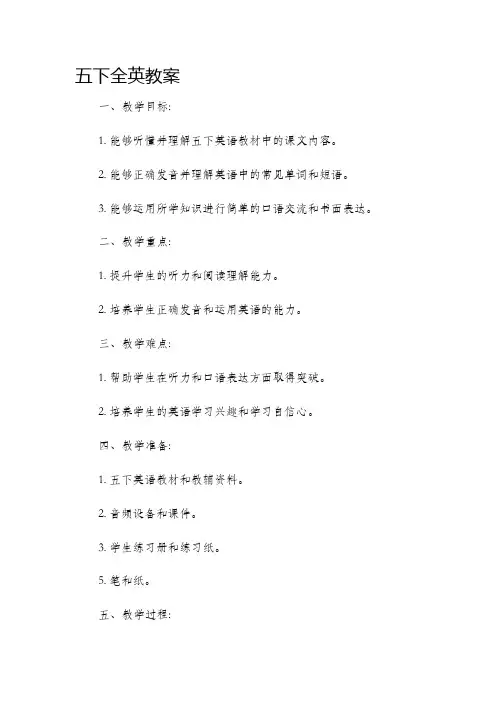
五下全英教案一、教学目标:1. 能够听懂并理解五下英语教材中的课文内容。
2. 能够正确发音并理解英语中的常见单词和短语。
3. 能够运用所学知识进行简单的口语交流和书面表达。
二、教学重点:1. 提升学生的听力和阅读理解能力。
2. 培养学生正确发音和运用英语的能力。
三、教学难点:1. 帮助学生在听力和口语表达方面取得突破。
2. 培养学生的英语学习兴趣和学习自信心。
四、教学准备:1. 五下英语教材和教辅资料。
2. 音频设备和课件。
3. 学生练习册和练习纸。
5. 笔和纸。
五、教学过程:1. 导入 (5分钟)通过出示一些图片和实物,引起学生对新课的兴趣,并让学生猜测将要学习的内容。
2. 听力训练 (15分钟)通过播放教材中的听力材料,让学生在理解人物对话的基础上回答问题。
教师应该用简单易懂的语言表达问题,并根据学生的水平适当调整难度。
3. 语言知识的学习和运用 (20分钟)教师根据教材中的语法和词汇内容,设计相关的练习让学生进行口头或书面表达。
例如,学习天气描述的单词和短语后,让学生描述自己所在城市的天气情况,并与同桌分享。
4. 听写和默写 (15分钟)通过读出单词和句子,让学生进行听写和默写练习,以提高他们的拼写和记忆能力。
5. 语音练习 (10分钟)通过指导学生正确发音和模仿教材中的录音,帮助学生纠正发音错误,并培养他们的口语表达和听力能力。
6. 情景对话和角色扮演 (20分钟)在教师的指导下,学生分小组进行情景对话和角色扮演。
每个小组设计一个对话场景,学生需要用英语进行对话和表演。
教师可以根据学生的熟练程度安排适当的角色扮演内容。
7. 总结和复习 (5分钟)教师对本节课所学内容进行总结和复习,检查学生对知识的掌握程度,并提出下节课的预习内容。
六、课后作业:1. 完成教材中的练习题目。
2. 复习本节课所学的词汇和句子。
3. 预习下节课的内容。
七、教学反思:通过这节课的教学实践,我发现学生对英语学习的积极性有所提高,能够更好地理解课文内容,并且在口语表达方面也有所进步。
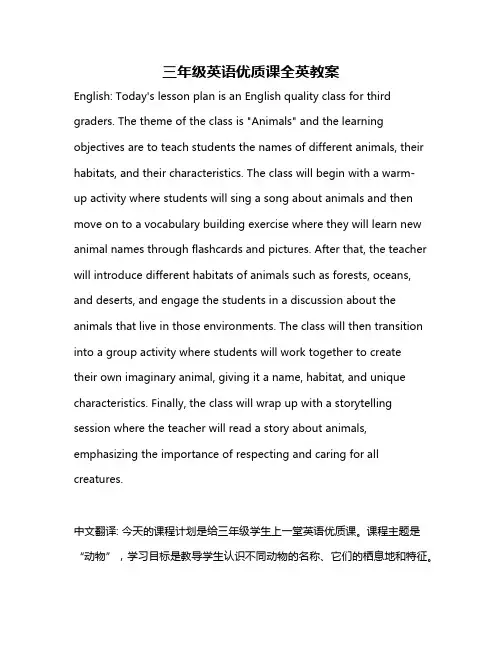
三年级英语优质课全英教案English: Today's lesson plan is an English quality class for third graders. The theme of the class is "Animals" and the learning objectives are to teach students the names of different animals, their habitats, and their characteristics. The class will begin with a warm-up activity where students will sing a song about animals and then move on to a vocabulary building exercise where they will learn new animal names through flashcards and pictures. After that, the teacher will introduce different habitats of animals such as forests, oceans, and deserts, and engage the students in a discussion about the animals that live in those environments. The class will then transition into a group activity where students will work together to createtheir own imaginary animal, giving it a name, habitat, and unique characteristics. Finally, the class will wrap up with a storytelling session where the teacher will read a story about animals, emphasizing the importance of respecting and caring for all creatures.中文翻译: 今天的课程计划是给三年级学生上一堂英语优质课。
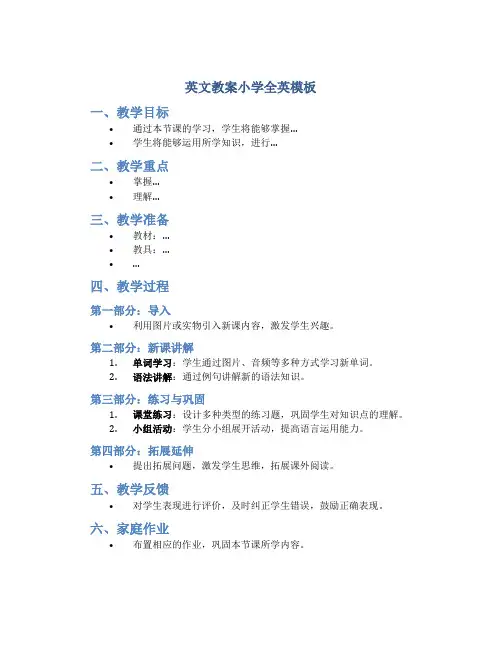
英文教案小学全英模板
一、教学目标
•通过本节课的学习,学生将能够掌握…
•学生将能够运用所学知识,进行…
二、教学重点
•掌握…
•理解…
三、教学准备
•教材:…
•教具:…
•…
四、教学过程
第一部分:导入
•利用图片或实物引入新课内容,激发学生兴趣。
第二部分:新课讲解
1.单词学习:学生通过图片、音频等多种方式学习新单词。
2.语法讲解:通过例句讲解新的语法知识。
第三部分:练习与巩固
1.课堂练习:设计多种类型的练习题,巩固学生对知识点的理解。
2.小组活动:学生分小组展开活动,提高语言运用能力。
第四部分:拓展延伸
•提出拓展问题,激发学生思维,拓展课外阅读。
五、教学反馈
•对学生表现进行评价,及时纠正学生错误,鼓励正确表现。
六、家庭作业
•布置相应的作业,巩固本节课所学内容。
七、教后反思
•总结本节课教学过程,查找不足并设想改进方法。
这个教案模板旨在帮助老师规划和设计一堂全英文的小学英语课程,灵活运用各种教学方法,提高学生的学习兴趣和语言运用能力。
希望能为您的英语教学提供一定的参考价值。
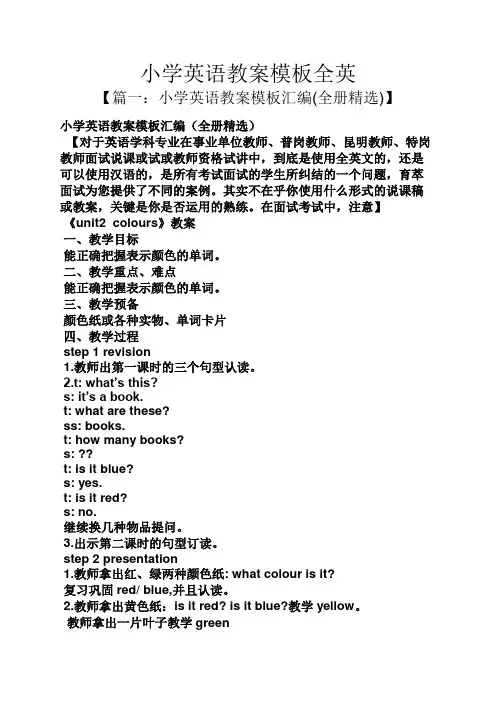
小学英语教案模板全英【篇一:小学英语教案模板汇编(全册精选)】小学英语教案模板汇编(全册精选)【对于英语学科专业在事业单位教师、普岗教师、昆明教师、特岗教师面试说课或试或教师资格试讲中,到底是使用全英文的,还是可以使用汉语的,是所有考试面试的学生所纠结的一个问题,育萃面试为您提供了不同的案例。
其实不在乎你使用什么形式的说课稿或教案,关键是你是否运用的熟练。
在面试考试中,注意】《unit2 colours》教案一、教学目标能正确把握表示颜色的单词。
二、教学重点、难点能正确把握表示颜色的单词。
三、教学预备颜色纸或各种实物、单词卡片四、教学过程step 1 revision1.教师出第一课时的三个句型认读。
2.t: what’s this?s: it’s a book.t: what are these?ss: books.t: how many books?s: ??t: is it blue?s: yes.t: is it red?s: no.继续换几种物品提问。
3.出示第二课时的句型订读。
step 2 presentation1.教师拿出红、绿两种颜色纸: what colour is it?复习巩固red/ blue,并且认读。
2.教师拿出黄色纸:is it red? is it blue?教学yellow。
教师拿出一片叶子教学green教师拿出一个自制的红绿灯教学一首小诗:red, red stop;yellow yellow wait;green green go go go!3. t show an orange: what’s this ? it’s an orange. what colour is it? it’s orange.t: orange is orange.4.show a peach:what colour is it? it’s pink.教学粉红色。
5. show a chocolate: what colour is it? it’s brown.教学棕色。
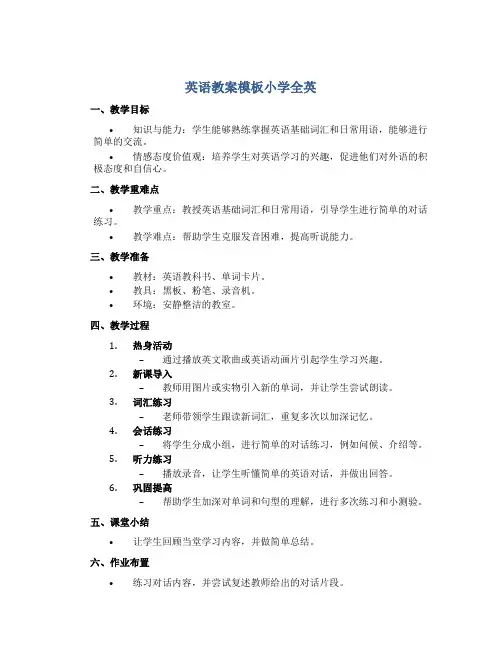
英语教案模板小学全英
一、教学目标
•知识与能力:学生能够熟练掌握英语基础词汇和日常用语,能够进行简单的交流。
•情感态度价值观:培养学生对英语学习的兴趣,促进他们对外语的积极态度和自信心。
二、教学重难点
•教学重点:教授英语基础词汇和日常用语,引导学生进行简单的对话练习。
•教学难点:帮助学生克服发音困难,提高听说能力。
三、教学准备
•教材:英语教科书、单词卡片。
•教具:黑板、粉笔、录音机。
•环境:安静整洁的教室。
四、教学过程
1.热身活动
–通过播放英文歌曲或英语动画片引起学生学习兴趣。
2.新课导入
–教师用图片或实物引入新的单词,并让学生尝试朗读。
3.词汇练习
–老师带领学生跟读新词汇,重复多次以加深记忆。
4.会话练习
–将学生分成小组,进行简单的对话练习,例如问候、介绍等。
5.听力练习
–播放录音,让学生听懂简单的英语对话,并做出回答。
6.巩固提高
–帮助学生加深对单词和句型的理解,进行多次练习和小测验。
五、课堂小结
•让学生回顾当堂学习内容,并做简单总结。
六、作业布置
•练习对话内容,并尝试复述教师给出的对话片段。
七、课后反思
•教师对本节课的教学进行总结和反思,为下节课做好准备。
以上为英语教案模板,建议老师根据具体情况进行适当调整,以促进学生的英语学习效果。

英文教案小学全英第一部分:引言英语作为一门全球通用的语言,在现代社会中愈发重要。
因此,教育界对英语教学提出了更高的要求。
本文旨在探讨小学英语教学的重要性及如何设计一份全英教案。
第二部分:小学英语教学的重要性小学是学生语言能力发展的黄金时期。
通过小学英语教学,可以培养学生的英语听、说、读、写能力,为他们未来的学习和工作打下坚实基础。
此外,英语作为一门通识技能,可以拓宽学生的视野,增加他们的国际竞争力。
第三部分:全英教案的设计原则1.简明清晰:教案内容应该简洁易懂,清晰明了,以便师生理解和实施。
2.符合学生水平:教学内容应当根据学生英语水平灵活调整,避免过于简单或过于复杂。
3.具有针对性:根据学生的特点和需求,设计具有针对性的教学活动,使学生更容易接受和吸收知识。
4.注重实践:教学内容应该贴近实际生活,注重实践操作,帮助学生更好地掌握英语知识和技能。
第四部分:全英教案示例一、听力练习•目标:培养学生对英语听力的理解能力。
•活动:播放英语短文,要求学生听懂并回答相关问题。
•评价:通过学生回答问题的情况评估他们的听力水平,并及时给予反馈。
二、口语练习•目标:提高学生的口语表达能力。
•活动:利用角色扮演或小组讨论的方式,让学生运用所学知识进行口语练习。
•评价:观察学生口语表达的流畅度和准确性,鼓励学生多参与,提高口语水平。
三、阅读指导•目标:培养学生的阅读理解能力。
•活动:让学生阅读适合水平的英语文章,并针对性地布置相关问题。
•评价:通过学生对问题的回答,了解其阅读理解情况,及时纠正错误,提高理解能力。
结语英语教学是一项重要的任务,尤其对于小学阶段的学生来说更为关键。
设计一份全英教案,是提高教学质量和学生学习效果的关键之一。
希望本文对教师们设计英文教案提供一些参考,让英语教学更加富有成效。
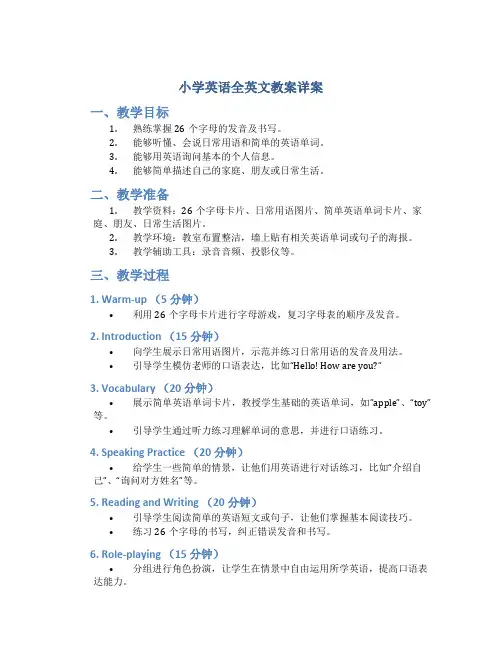
小学英语全英文教案详案一、教学目标1.熟练掌握26个字母的发音及书写。
2.能够听懂、会说日常用语和简单的英语单词。
3.能够用英语询问基本的个人信息。
4.能够简单描述自己的家庭、朋友或日常生活。
二、教学准备1.教学资料:26个字母卡片、日常用语图片、简单英语单词卡片、家庭、朋友、日常生活图片。
2.教学环境:教室布置整洁,墙上贴有相关英语单词或句子的海报。
3.教学辅助工具:录音音频、投影仪等。
三、教学过程1. Warm-up (5分钟)•利用26个字母卡片进行字母游戏,复习字母表的顺序及发音。
2. Introduction (15分钟)•向学生展示日常用语图片,示范并练习日常用语的发音及用法。
•引导学生模仿老师的口语表达,比如“Hello! How are you?”3. Vocabulary (20分钟)•展示简单英语单词卡片,教授学生基础的英语单词,如”apple”、“toy”等。
•引导学生通过听力练习理解单词的意思,并进行口语练习。
4. Speaking Practice (20分钟)•给学生一些简单的情景,让他们用英语进行对话练习,比如“介绍自己”、“询问对方姓名”等。
5. Reading and Writing (20分钟)•引导学生阅读简单的英语短文或句子,让他们掌握基本阅读技巧。
•练习26个字母的书写,纠正错误发音和书写。
6. Role-playing (15分钟)•分组进行角色扮演,让学生在情景中自由运用所学英语,提高口语表达能力。
四、巩固练习•布置英语练习作业,包括课上所学内容的复习和巩固。
•鼓励学生在家与家人朋友用英语进行简单交流。
五、总结反馈•结束教学课程后,对学生学习情况进行简要总结,并对表现优秀的学生进行表扬和鼓励。
•同时收集学生的反馈意见,不足之处进行改进。
以上是本节小学英语全英文课程的详细教案,希望通过本次教学能够激发学生学习英语的兴趣,提高他们的英语水平。
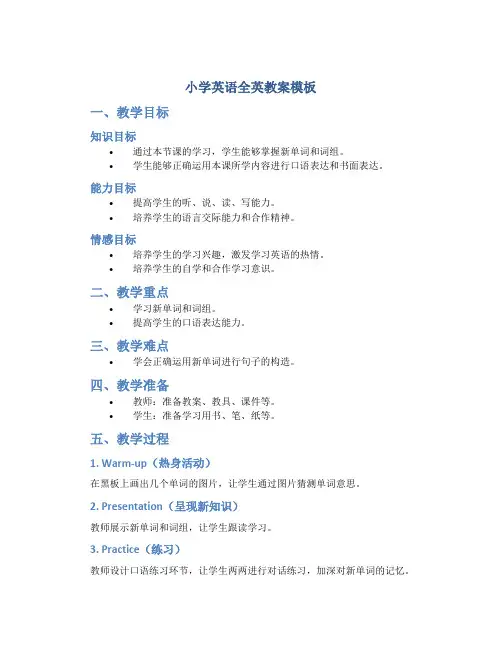
小学英语全英教案模板
一、教学目标
知识目标
•通过本节课的学习,学生能够掌握新单词和词组。
•学生能够正确运用本课所学内容进行口语表达和书面表达。
能力目标
•提高学生的听、说、读、写能力。
•培养学生的语言交际能力和合作精神。
情感目标
•培养学生的学习兴趣,激发学习英语的热情。
•培养学生的自学和合作学习意识。
二、教学重点
•学习新单词和词组。
•提高学生的口语表达能力。
三、教学难点
•学会正确运用新单词进行句子的构造。
四、教学准备
•教师:准备教案、教具、课件等。
•学生:准备学习用书、笔、纸等。
五、教学过程
1. Warm-up(热身活动)
在黑板上画出几个单词的图片,让学生通过图片猜测单词意思。
2. Presentation(呈现新知识)
教师展示新单词和词组,让学生跟读学习。
3. Practice(练习)
教师设计口语练习环节,让学生两两进行对话练习,加深对新单词的记忆。
4. Production(表达)
要求学生运用新学的单词和词组进行句子编写,展示个人观点。
5. Homework(作业布置)
布置相关作业,巩固所学内容。
六、教学反思
经过本节课的教学,学生对新单词的掌握情况如何?口语表达能力有所提高吗?如何改进教学方式提高学生的学习兴趣?
这份全英文教案模板力求通过多种学习方式和环节的设计,引导学生在轻松愉
悦的氛围中学习英语,培养其语言交际能力和合作精神,为日后的学习打下坚实的基础。
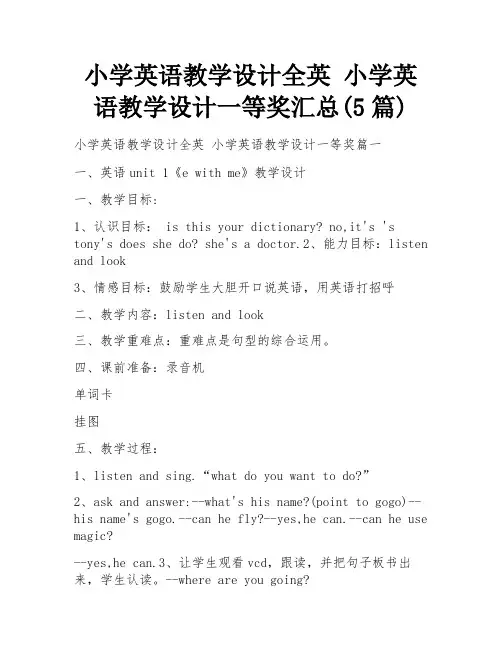
小学英语教学设计全英小学英语教学设计一等奖汇总(5篇)小学英语教学设计全英小学英语教学设计一等奖篇一一、英语unit 1《e with me》教学设计一、教学目标:1、认识目标: is this your dictionary? no,it's 'stony's does she do? she's a doctor.2、能力目标:listen and look3、情感目标:鼓励学生大胆开口说英语,用英语打招呼二、教学内容:listen and look三、教学重难点:重难点是句型的综合运用。
四、课前准备:录音机单词卡挂图五、教学过程:1、listen and sing.“what do you want to do?”2、ask and answer:--what's his name?(point to gogo)--his name's gogo.--can he fly?--yes,he can.--can he use magic?--yes,he can.3、让学生观看vcd,跟读,并把句子板书出来,学生认读。
--where are you going?--i'm going to an island.--we can't fly.--e withme./let's go.4、师生操练、生生操练句型。
5、呈现listen and look,要求学生把听到的句子说出来。
6、pair work and act.7、point and say.8、homework(1)把课文读给家长听。
(2)表演与同学的对话,用英语问候老师和同学。
六、板书设计: unit one e with me--where are you going?--i'm going to an island.--we can't fly.--e with me./let's go.七、教学反思:小部分学生比较难上口,需要反复读说。
小学英语全英说课稿Book4Unit5 B_人教四年级下Unit 6Lesson 6教学设计教案是教师为顺利而有效地开展教学活动,根据课程标准,教学大纲和教科书要求及学生的实际情况,以课时或课题为单位,对教学内容、教学步骤、教学方法等进行的具体设计和安排的一种实用性教学文书。
今天小编给大家带来小学英语全英说课稿Book4Unit5 B_人教四年级下Unit 6 Lesson 6教学设计,希望可以帮助到大家。
The Lecture Notes of 《 PEP Primary English 》Book4 Unit5 B Let’s talkLadies and Gentlemen, It’s my great pleasure to be here sharing my lesson with you.The content of my lesson is《 PEP Primary English 》Book4 Unit5 B Let’s talk, as king the price and inquiring the clothes size.First, let me talk about the teaching material.Part 1 Teaching Material:This lesson is about a shopping topic. By study of this unit, the Ss know how to ask the price in English and how to describe the size and price with simple words and sentences. The sentence patterns of this lesson “ What size?” “How much are they?” and“We’ll take them .”are the key and difficult points of this unit.The study of this lesson will help the Ss with daily communication.Moreover, this lesson completes the transition of the phrase “a pair of… ”to the sentence pattern “A pair of… for …” ,and helps the Ss further consolidate the knowledge of words of clothing appearing in plural form.Therefore, on studying the teaching material and analyzing the regulation of children’s growing of mind,I put forward the teaching objectives according to English syllabus and new lessonstandard.1.Perception objective:a)The Ss can hear, read, and use the main sentence patterns “A pair of … for …” “What size?” “How much are they?” “We' ll take them.”b)The Ss can understand and read the conversation of the lesson.2.Ability objective:a)The Ss can use the sentence pattern of inquiring the price, and further develop their language ability of “shopping”;b)The Ss can use the patterns to express their thoughts in the proper scene.3.Emotion objective:a)By completing the task,the Ss increase their interest and set up self-confidence in language study;b)Teach the Ss what is “love” and “ managing money matters”, put the moral education in the language study.Next,the key points of this lesson:First of all, to study and use the sentence patterns “What size?”“How much are they ?”“A pair of … for … .” “We' ll take them.”To improve the Ss’ abilities in “shopping”;Secondly, teach the Ss how to study independently as well as by cooperation.Difficult points:The Ss can use the words and patterns to describe the clothes in the proper scene, and make simple dialogues of shopping.Well, how to achieve the teaching objectives better, to stress the key points and break through the difficult points? The key is how to make use of the proper teaching methods, I’ll talk about my teaching methods below.Part 2 Teaching Methods:According to the modern perception theories and social intercourse teaching theories, I adopt the TSA method and TBLT method in my teaching, namely T otal Situational Action and Task-based Language T eaching.The former is a “scene —activity” teaching method .It establishes a real scene and the interaction between the teacher and the Ss .It emphasizes a dynamic information exchange between the teacher and Ss.The latter offers the Ss an opportunity to complete the tasks in which Ss use language to achieve a specific outcome. The activity reflects real life and learners focus on meaning, they are free to use any language they want.At the same time, make use of the modern electricity teaching equipments and all kinds of teaching means, it can mobilize the Ss’ enthusiasm and creativity in learning Engl ish.Part 3 Studying Methods:Let Ss study in a relaxed and agreeable atmosphere. Ss understand the new knowledge in certain degree through the mental process of seeing, hearing, saying, observing, imagining , thinking etc. And make preparation for completing the new study task.After feeling and comprehending the language points, let Ss obtain the knowledge actively by probe study and cooperative study. Thereby, develop the Ss’ abilities of studying and working with the learning language independently.Part 4 Teaching Process:In order to realize the teaching process systematically, properly and efficiently, under the principle of “regard Ss as the corpus, the teacher inspires for predominance”, I divide theteaching process into five steps.Step1 Warm-up.Sing a song: The coat in window.So as to the psychological characteristics of children,singing a song can make Ss feel pleased and satisfied, and can arouse exciting motion. In this step , teacher and the Ss sing in unison and perform the song “The coat in window.” Thus,review the sentence pattern “How much is … ?” And arouse the Ss' performance desire, participation desire,and lead the Ss into a thick English studying atmosphere.Step2 Presentation and practice.1.Design: Look for Cinderella.Broadcast a part of “Cinderella” with the flash, presenting a crystal shoe that Cinderella lose, and establishes a scene of ministers look for the proper size everywhere. Through the role playing, guide the Ss to use the sentence pattern “What size do you wear?” “Size… .”to make the question and answer.This design is a novelty of my lesson,it leads the Ss into the fairy tales. They acquire the language unconsciously and can do communication freely.2.Lead to the shopping topic naturally from the unsuited shoes, and de monstrate the sentence pattern “How much are they?”With a good student to be the assistant, I perform to go shopping, and guide the Ss to make the answer: “They are … .”In this course, Ss can understand the main contents of this dialogue and get the key points by scene demonstration.3.Game:Guess the price.From buying a pair of shoes for myself to buying a pair for my mom, introduce the sentence pattern “A pair of … for … .”The CAI presents a big cabinet with various shoes, ask the Ss to guess their price, and then display them.It considers that children can keep their attentions in limited time. The game can avoid the lifelessness and boredom from the pure machine drills .It creates the conditions of a relaxed and natural atmosphere for children’s d rills. Then achieve the aim of consolidating and deepening the sentence pattern.4.Present the text.a)At this time, John and his mom come to the shoe store.It reappears the relevant conversation by broadcasting the VCD, let Ss know the text contents with a combination of audio and video, words and pictures, which cater to the characteristics of primary period to be curious and pursuing interest and freshness.b)After the audio-visual commences, play the tape recorder completely again, let the Ss concentrate on listening, then answer my questions according to the dialogue. e.g.:What size does John wear? How much? Whether buy or not, etc.c)After be familiar with the text, let the Ss try to act out the dialogue.By this step, it achieved the teaching aim of understanding and talking the dialogue of this lesson.Step3 Task time.Task:Mother’s Day.To master the language capability needs certain amount of practice.So,I still adopt the “Task-based”teaching method, which is defined by strong practicality and exact task, so as to make break-through about the difficult points of this lesson.In advance, I shall arrange the classroom to some business locations, such as clothes store, shoes store, fruit store etc. I shalldivide the class into groups and play roles, and then give the Ss a certain quantity of specie currency, so that they may choose and buy the gifts for Mother’s Day.For this step, I shall instruct the Ss to use the words and patterns learnt in the process of completing certain tasks. Meanwhile, they may have mutual improvement in exchanging information during the communicating activities.Most Ss can take their parts in the activities, especially for the Ss who have trouble in English study. In the group activities, they can speak a little English with ease. With no doubt, this will encourage them to speak English.In fact, it incarnates a kind of demand of human being.Suhuomulinsiji says:“In one’s mind, there is always a kind of deeply rooted demand, that is the hope to feel oneself a finder and explorer. In Ss’ spirits, such demand is specially strong.”This step also leads to the emotion objective of this lesson, that is to have moral education in this step.Step4 Consolidation and extension.Summarize the whole lesson,and arrange the homework.1.Do the correlative exercises in the activity book.Check the mastering of knowledge of this lesson.2.Ask Ss to interview their friends asking the price and size of their clothing and make records of the information.This content is an extension of the previous lesson, to meet the needs of increasing communicating demand of some Ss.Step5 Blackboard Design.Show on the CAI.(It’s a ….)Anyway, the teaching of this lesson aims to develop not only the Ss' language technical abilities, but also the diverse intelligence by integrated teaching methods.As teachers, to make our English classrooms shine with vitality, we are laid with heavy burden, and we still have long way to go.全英教案人教版小学英语四年级下Unit 6 Lesson 6教学设计1. Teaching aims Let the students to master : family, parents, uncle, aunt, baby, come, who, basketball player, people, member, only, puppy, gee, look, young brother, sister, father, mother, driver, doctor, farmer, nurse2. Teaching aids A projector ,a tape recorde, some pictures and photos3. Teaching steps 1)Greetings Say “Hello” to everybody, talk something about the weather and the date.Then sing a song named “ An apple a day makes a doctor away”. 2)Revision Do the exercise on page 76. Ask them to do it in groups and make some coments. Do the exercise “Let’s check” listening to the tape. Then check them in pairs. Do the exercise “Let’s find out” to see how many words can they find in the letters. Tell the main idea of the story in English and ask the students to read it by themselves. Ask them to circle the difficult words and expressions. Choose one or 2 students to come to the front to tell others the meaning of the story. Then the teacher correct him/her. Read the exercise “Good to know” and say sth about it. 3)Sing a song Learn a new song named “My fathe r is a doctor”by listening to the tape.4. Homework Let them to remember the new words in this unit and recite the texts in this unit.5. Teaching notes。
英语教案模板小学全英一、教学目标在本课中,学生将学习以下内容:•学习并掌握单词:苹果、香蕉、橙子、西瓜、葡萄、草莓、梨子。
•学习并运用句型:I like…(我喜欢…)、Do you like…?(你喜欢…吗?)。
•能够进行基本的水果询问和表达。
二、教学重难点1.教学重点:让学生学会运用句型进行简单的水果询问和表达。
2.教学难点:帮助学生正确运用句型进行对话交流。
三、教学准备1.单词卡片:苹果、香蕉、橙子、西瓜、葡萄、草莓、梨子。
2.教学PPT。
四、教学过程1. 导入(5分钟)通过展示水果图片引起学生的兴趣,并复习一些已学过的水果的单词。
2. 学习新知(15分钟)1.出示单词卡片依次教授新单词,并让学生大声跟读。
2.帮助学生理解并掌握新句型,以“I like…”为例进行展示和操练。
3. 对话练习(20分钟)1.将学生分成小组,进行简单的对话练习。
其中一人选择一种水果,并询问其他成员是否喜欢这种水果。
其他成员用“I like…”或“I don’t like…”来回答。
2.引导学生进行实际情境对话练习,例如购物时向售货员询问水果。
4. 游戏活动(15分钟)1.设计一个游戏活动,让学生在课堂上进行竞赛。
每组学生派出一名代表,向其他小组成员提问题,询问他们喜欢哪种水果。
被问到的学生要用“I like…”或“不喜欢…”回答。
2.记录每组的得分并宣布获胜组。
5. 总结和小结(5分钟)回顾本节课所学内容,总结学生们在对话和游戏中的表现,并强调学生正确应用所学知识的重要性。
五、课堂作业1.小组合作:编写一段对话,运用本节课所学的句型和单词,进行水果询问和表达。
2.完成课堂练习题。
六、教学反思本节课通过多种教学方法,如图片引导、游戏活动等,增加了学生的参与度和兴趣。
学生们积极参与讨论和练习,对所学内容有了初步的掌握。
在今后的教学中,可以进一步提高学生的表达能力,增加更多的实际情境对话练习,激发学生的学习兴趣和主动性。
人教版小学英语全英教案【篇一:小学英语优秀教学设计】小学英语优秀教学设计(一)小学英语第五册(外研版)module 8 schoolunit 1 what time does school start?蓬莱市南王中心小学包晓晴一、教材分析module 8 book 5 的主题是“school”,“ unit 1 what time does school start?”的语言功能是描述学校生活;学习任务为“what time does school start? what time do you get up?”二、学情分析本课的教学对象是五年级学生,他们已经掌握了一定的英语词汇,具有一定的英语学习的积极性与主动性,具备了一定的英语语言运用能力,求知欲增强。
因此,在新知识传授的同时,教师要尽可能多的为学生创造良好的语言环境,给学生充足的语言“习得”机会,让学生在学习中积极参与、大胆发言,从而形成积极的情感态度和自主学习的能力。
三、教学目标(一)知识目标1、能听懂、会说并认读下列单词:exercise, before, playground, skip, coffee, tea.2、能听懂、会说并认读下列句子:what time does school start? my school starts at 9 o?clock. what time do you get up? i get up at half past seven.(二)能力目标能口头运用“what time does school start?”这类语句询问发生的时间,并能口头运用“my school starts at 9 o?clock.”这类语句回答。
(三)情感目标为学生创设轻松、愉悦、和谐的英语课堂学习氛围,使学生在学习中敢于开口说英语,并了解西方小学学校日常生活习惯,从而对英语学习产生更为浓厚的兴趣。
四、教学要点分析(一)教学重点1.单词:exercise, before, playground, skip, coffee, tea 的认读。
英语教案设计范文全英
第一部分:教学目标
1. 目标描述
本节课的教学目标旨在帮助学生掌握英语中的基础语法和词汇知识,以便能够流利地进行日常对话和交流。
2. 学习内容
•英语基础语法知识
•常用英语词汇
3. 学习目标
•理解并正确运用英语基础语法规则
•能够准确地运用所学词汇进行口语表达
第二部分:教学过程
1. Warm-up (10分钟)
•通过简短的问候和介绍活动引导学生进入学习状态。
2. Presentation (20分钟)
•通过例句和语法规则的讲解来帮助学生理解英语的语法知识。
•演示并让学生模仿正确的口语表达方式。
3. Practice (30分钟)
•分组进行练习,让学生在实际交流中运用所学知识。
•组织口语练习,让学生能够流利地进行对话。
4. Production (20分钟)
•让学生展示他们在课堂中学到的知识,进行口语表达。
•根据实际情况给予指导和反馈。
第三部分:教学评估
1. 评估方式
•通过学生的口语表达和课堂表现来评估他们对所学知识的掌握程度。
2. 评估标准
•能够准确使用所学语法知识进行口语表达
•能够流利地进行日常对话和交流
第四部分:课堂总结
通过本节课的学习,学生应该掌握了日常英语中的基础语法知识和常用词汇,能够更加流利地进行英语口语表达。
希望同学们在日常生活中多加练习,巩固所学知识,提高自己的英语能力。
以上是本节课的教案设计范文,希望对教师有所帮助。
小学英语教师全英教案一、Lesson 1: Greetings and IntroductionsObjective:Students will be able to introduce themselves and greet others in English. Materials:Flashcards with pictures of different greetings and introductions. Procedure:1. Begin the class with a warm-up activity. Ask students to introduce themselves in their native language and then translate it into English.2. Show the flashcards with pictures of different greetings and introductions. Ask students to guess the meaning of each picture.3. Expln and demonstrate each greeting and introduction, such as "Hello, my name is", "Nice to meet you", "How are you?", etc.4. Practice role-playing with students, where they can practice using the greetings and introductions in different scenarios.5. Summarize the key points of the lesson and encourage students to practice using the greetings and introductions in their dly lives.二、Lesson 2: ColorsObjective:Students will be able to name and recognize different colors in English. Materials:Flashcards with pictures of different colors.Procedure:1. Begin the class with a discussion about colors. Ask students if they know any colors in English.2. Show the flashcards with pictures of different colors. Ask students to guess the name of each color.3. Expln and demonstrate the names of each color, such as "red", "blue", "green", etc.4. Practice identifying and naming the colors using objects in the classroom, such as a red pen, a blue book, etc.5. Summarize the key points of the lesson and encourage students to practice naming colors in their dly lives.三、Lesson 3: Numbers 1-10Objective:Students will be able to count from 1 to 10 in English.Materials:Flashcards with numbers 1-10.Procedure:1. Begin the class with a discussion about numbers. Ask students if they know any numbers in English.2. Show the flashcards with numbers 1-10. Ask students to guess the number represented each flashcard.3. Expln and demonstrate how to count from 1 to 10 in English.4. Practice counting with students using objects in the classroom, such as counting the number of desks, chrs, etc.5. Summarize the key points of the lesson and encourage students to practice counting in their dly lives.四、Lesson 4: Days of the WeekObjective:Students will be able to name and recognize the days of the week in English.Materials:Flashcards with the days of the week.Procedure:1. Begin the class with a discussion about the days of the week. Ask students if they know any days of the week in English.2. Show the flashcards with the days of the week. Ask students to guess the name of each day.3. Expln and demonstrate the names of each day of the week, such as "Monday", "Tuesday", "Wednesday", etc.4. Practice naming the days of the week using a calendar or a schedule.5. Summarize the key points of the lesson and encourage students to practice naming the days of the week in their dly lives.五、Lesson 5: Months of the YearObjective:Students will be able to name and recognize the months of the year in English.Materials:Flashcards with the months of the year.Procedure:1. Begin the class with a discussion about the months of the year. Ask students if they know any months in English.2. Show the flashcards with the months of the year. Ask students to guess the name of each month.3. Expln and demonstrate the names of each month of the year, such as "January", "February", "March", etc.4. Practice naming the months of the year using a calendar or a schedule.5. Summarize the key points of the lesson and encourage students to practice naming the months of the year in their dly lives.六、Lesson 6: Family MembersObjective:Students will be able to name and recognize family members in English. Materials:Flashcards with pictures of family members.Procedure:1. Begin the class with a discussion about family. Ask students to name their family members in their native language.2. Show the flashcards with pictures of family members. Ask students to guess the name of each family member.3. Expln and demonstrate the names of each family member in English, such as "mother", "father", "sister", etc.4. Practice role-playing with students, where they can practice using the names of family members in different scenarios.5. Summarize the key points of the lesson and encourage students to practice naming family members in their dly lives.七、Lesson 7: AnimalsObjective:Students will be able to name and recognize different animals in English. Materials:Flashcards with pictures of different animals.Procedure:1. Begin the class with a discussion about animals. Ask students if they know any animals in English.2. Show the flashcards with pictures of different animals. Ask students to guess the name of each animal.3. Expln and demonstrate the names of each animal, such as "cat", "dog", "bird", etc.4. Practice identifying and naming the animals using objects in the classroom, such as a toy cat, a picture of a dog, etc.5. Summarize the key points of the lesson and encourage students to practice naming animals in their dly lives.八、Lesson 8: Food and DrinkObjective:Students will be able to name and recognize different foods and drinks in English.Materials:Flashcards with pictures of different foods and drinks.Procedure:1. Begin the class with a discussion about food and drink. Ask students if they know any foods and drinks in English.2. Show the flashcards with pictures of different foods and drinks. Ask students to guess the name of each item.3. Expln and demonstrate the names of each food and drink, such as "apple", "milk", "water", etc.4. Practice identifying and naming the foods and drinks using objects in the classroom, such as a banana, a bottle of water, etc.5. Summarize the key points of the lesson and encourage students to practice naming foods and drinks in their dly lives.九、Lesson 9: ClothingObjective:Students will be able to name and recognize different articles of clothingin English.Materials:Flashcards with pictures of different articles of clothing.Procedure:1. Begin the class with a discussion about clothing. Ask students if they know any articles of clothing in English.2. Show the flashcards with pictures of different articles of clothing. Ask students to guess the name of each item.3. Expln and demonstrate the names of each article of clothing, such as "shirt", "pants", "socks", etc.4. Practice identifying and naming the articles of clothing using objects in the classroom, such as a sweater, a pr of shoes, etc.5. Summarize the key points of the lesson and encourage students to practice naming articles of clothing in their dly lives.十、Lesson 10: Review and AssessmentObjective:Students will demonstrate their understanding of the concepts covered in the previous lessons through a review activity.Materials:Review worksheet with fill-in-the-blank and multiple-choice questions. Procedure:1. Begin the class with a brief review of the concepts covered in theprevious lessons.2. Hand out the review worksheet to students and expln that they will have a short assessment to test their knowledge.3. Allow students time to plete the worksheet, providing assistance as needed.4. Collect the worksheets and assess students' understanding of the concepts.5. Provide feedback to students on their performance and review any areas that need improvement.重点解析本文为小学英语教师全英教案,共包含十个章节。
【导语】教案是教师为顺利⽽有效地开展教学活动,根据课程标准,教学⼤纲和教科书要求及学⽣的实际情况,以课时或课题为单位,对教学内容、教学步骤、教学⽅法等进⾏的具体设计和安排的⼀种实⽤性教学⽂书。
以下是⽆忧考整理的《⼩学英语教案全英⽂版范⽂》相关资料,希望帮助到您。
⼩学英语教案全英⽂版范⽂篇⼀ Unit 1 How do you go there? Period One Teaching contents: Part A let’s learn & let’s play Teaching aims: 1. To enable the students to master the four skills phrases: on foot,by bike,by bus,by train, by plane,by ship,by subway 2. To enable the students to ask about the ways of traffic with the following sentence patterns: How do you go to school? Or How do you go to Canada…?‖And answer with―I go by…‖ Teaching focus: To master the four skills phrases: by train, by plane, by subway, by ship, by bike, on foot Teaching difficulty: To differ ―subway‖ from―train‖ Teaching methods: Communicative Approach Teaching aids: 1. Word cards 2. Tape recorder and tape 3. Multi-media player Teaching procedure: 1. (Warm-up) Greeting: Good morning , class ! Glad to meet you again. How are you? What day is it? What ‗s the date? What‘s the weather like today? 2. Presentation Show a picture of bus T: What‘s this? S: It‘s a bus. T: I go to school by bus. How do you go to school? (Show a picture of bike and help a student to answer with ―I go to school by bike.‖) (In the same ways)Teach ―by subway‖ and ―by train‖―by ship‖―by plane‖―on foot‖. Subway: It's an underground railway in a city.It travels very fast.We can see subway in Hong Kong, Beijing, Shanghai,Gongzhou… Explain the differences between subway and train Pay attention to the pre. ― by‖& ―on‖ 3. Play games Ask one S to the front and stick the word cards next to the phrases written on the Bb when T read the new phrases quickly and the other Ss put up their cards. The one who reflect fastest and correctly is the winner. 4. Listen to the tape of Part A Let‘s learn and follow it. Pay attention to the tone and pronunciation 5. Practice: Let‘s play T Offer many places (the USA. England Australia Hong Kong Shanghai Guangzhou the moon…) and traffic ways (by car/ taxi/ bus… on foot) Ss practice with above places and ways in pairs: A: How do you go to school? B: I go to school on foot . Encourage the Ss to make up as many sentences as they can. 6. Spelling competition Divide the class into tow groups. Show the pictures of traffic tools and ask Ss to spell the phrases. The first one who puts up hand gets the chance to spell. The group spell out more phrases are the winners. Homework Copy the new words and phrases Finish Page1 of the AB⼩学英语教案全英⽂版范⽂篇⼆ Goood moring, I'm glad to interpret my lesson here . The lesson plan I am going to talk about is Part A let's learn of unit1 PEP Primary English book7. I will explain how to teach and the reason for doing this from following aspects. Ⅰ analysis of the teaching content. Ⅱ ways of teaching and learning . Ⅲ teaching procedures Ⅳ blackboard design V assessment Now Let’s focus on the analysis of teaching content. It can be divided into 3 parts as followed: the status and the function, the teaching objectives , the main points and difficult points, I’ll talk about it one by one. This lesson is the first lesson of unit 1, book7 . It includes two parts: Let’s learn and let’s play. In section 1, it mainly deals with these key phrases: on foot, by bike, by bus, by train, by subway. And in section 2, it provides a game for the Ss to prastise the patterns: How do you go to…? And the answer: I go… by../ on foot. Our students have already known some vehicles in the daily life. It’s not difficult for them to understand and use these words . If students can learn it well, it will help students to learn the rest of this unit. So, I set the following aims: The first is language objectives To make sure that students can read, recognize and use these key phrases :on foot ,by bike,by bus,by train skillfully. The next is ability objectives (1) To develop Ss’ abilities of listening and speaking. (2) To train the Ss’ ability of working in groups. moral objectives (1)to help students know some vehicles and comprehend the traffic rules (2) To foster Ss’ consciousness of good co-operation and proper competition. The main points and difficult points about this lesson is: (1) To make sure that Ss can use these key phrases correctly and skillfully. (2) To enable Ss to study in groups and co-operate skillfully. (3) To develop Ss’ interest in English. Difficult points To help the Ss ask and answer the question “How do you go to…? part Ⅱways of teaching and learning As we all know: the main instructional aims of learning English in primary school is to cultivate pupils’ basic abilities of listening and speaking and their good sense of the English language. So in this lesson I’ll mainly use “Task-based” teaching method. That is to say, I will let the Ss learn in real situations, finish a task by making a survey”How do you go to school?” to help Ss to get a better understanding of the key phrases. I will arrange these activities: guessing game, finishing a survey and having a competition. And in this lesson a recorder, CAI, will be needed. partⅢ teaching procedures I’ll finish this lesson in five steps. step1 lead--in activities I will begin my class with "drawing and guessing" game, just like this : I show students some vehicles such as bike ,bus ,jeep which they learned before by "Stick Figures" and ask them guess what’s it. Purpose: It is important to form a better English learning surrounding for the Ss by guessing game. and at the same time it provides situations to review learned knowledge for the next step. step2 prestentation Now I’ll mainly talk about this step. 1、first there is a Free talk between T and Ss. For example: I show many pictures of beautiful cities and ask students some questions, such as "do you like this city?where do you want to go ?"and help Ss to answer them with "by train ,by plane,by ship". By the way, I show the picture of a school, and say“ I go to schiool by bus” ,Ss read this sentence. do the actions and ask "how do you go to school?",show many pictures of tools such as ,on foot by bike ,by bus to help students answer my question one by one. To present the key structures one by one is much easier for the Ss to learn and grasp the meanings. 2 With the help of the CAI I set a situation to help Ss understand the way of using these key phrases: A boy is coming, who is going to school. He says: I go to school by.Then play the sounds of bus, bike ask students to listen carefully and tell “I go to school by." according to the different sounds, by the way , I present another new phrases:by subway Purpose:Make Ss use these new phrases with sentence structures, to help Ss use the language in a real situation.。
Teaching Plan
Lesson 9 Unit 5 (Book2)
——外语系********
✧Teaching Content:Unit5 Lesson9 Parts of the body(book2)
✧Students:Class 1 Grade 3
✧Trainee:Lai Qiuyan
aims:
aim:
1)New words:leg, hand, arm, foot, feet, knee
2)New sentences:
——How many legs/hands/arms/feet/ can you see?
——I can see __legs/hands/arms/feet.
3) Recite the chant fluency “Follow me”. Learn to sing a song of “Follow me”
4) To hear the instruction and performance.
aim:
Let students be more confident during the studying of English and get great fun from students' interests in English learning, cultivate the habit of independent study actively, lets the student in activity boldly self expression.
II. Class type: New teaching
III. Important and difficult points:
Let students can hear instruction and performance.
IV. Teaching preparation:cards, pictures
V .Teaching steps:
Step 1 Warming up
a song “Head, shoulders ,knees and toes.”
Step 2 Review
Group race. Look the picture and answer the questions.
——How many __can you see?
——I can see __.”(Lesson5 Unit3 Book1)
Step 3 Teaching the new lesson
Show the title of Unit5 Lesson9.
T: Today I will introduce a new friend to you. Do you want to know? Look, he’s coming. (Show a boy in the screen.)
T: His name is Dan.
Ss :( read after the teacher) His name is Dan.
T: Please say “Hello” to Dan.
Ss: Hello, Dan.
T: Today Dan has something to introduce to us. Do you want to know? Let’s have a look.
Step 4 Learning
1. (The screen has shown Dan’s knees.)
T: Oh, What’s this? It’s his knees.
Ss: Head. (Read after the teacher, and bend the knees.)
T: Follow me. Let’s do the knee exercise and read it together twice.
(Nod left, nod right, nod back, nod forward)
T: I say and you do. (Teacher says the words and students do the actions.) Point to/touch/bend your knees….
T: L et’s have a chant.
knee, knee, point to your knees;
knee, knee, touch your knees;
knee, knee, bend your knees. (Reading and doing.)
2. (The screen has shown Dan’s arms, use the same way to lead in
the arm.)
T: Show me your arm and read it, now let’s do arm by arm.
(One student stands up to say “arm”, and then he waves his arm and it goes on.)
T: Follow me:
Arm, arm, point to your arms; arm, arm, wave your arms.
3.(Show the hands.)
T: Show me your hand, and read it and don’t stop. (Teacher reads it and chooses some students to read.)
T: I say and you do. Clap/point to/touch your hands.
4.(Show the legs)
T: Leg. (Read and touch it.)
T: Point to/touch your leg.
T: Leg, leg, point to your leg; leg, leg, touch your leg.
5.(Show the feet)
Teacher stamp the foot and point it, and use the same way to practice it.
6. Learn the text.
Step 5 Game
Each group have a little teacher issue instructions on other students do the action, the students who do wrong sat down please, with the most students win the game.
Step 6 Chant then sing “Follow me ”
Step 7 Sum-up and Evaluation
Step 8 Homework
1. Listen to the tape and read after it.
2. ?To perform the activities manual exercises four to six.??
3. Preview the new lesson.
VI.The Design of the Blackboard Writing。